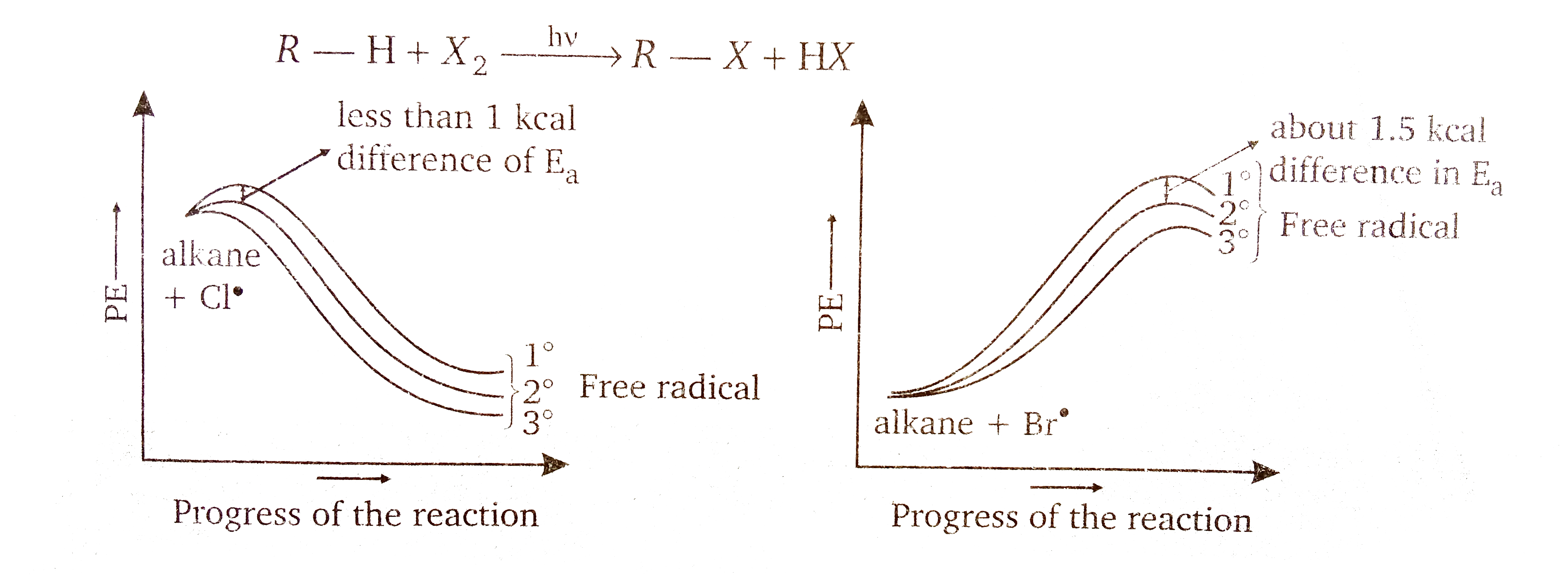Free radical substitution chalcogenation is hown by the compunds having least one H-atom an sp3 hyvbridised carbon atom. Here substitution is due to free radical formation in presence of sunlight or heat or peroxide.The abstruction of H-atom is on the basis of staability of free radical flrmed

Which of these H-atom can be substituted to get an optically active lhalide?
P
Q
R
S
The correct Answer is:B
The following Reaction are
Topper's Solved these Questions
- HYDROCARBONS (ALKANE, ALKENE and ALKYNE)BOOK - HIMANSHU PANDEYCHAPTER - HYDROCARBONS (ALKANE, ALKENE and ALKYNE)EXERCISE - Match The Column
12 Videos
- HYDROCARBONS (ALKANE, ALKENE and ALKYNE)BOOK - HIMANSHU PANDEYCHAPTER - HYDROCARBONS (ALKANE, ALKENE and ALKYNE)EXERCISE - Integer Answer Type Problems
10 Videos
- HYDROCARBONS (ALKANE, ALKENE and ALKYNE)BOOK - HIMANSHU PANDEYCHAPTER - HYDROCARBONS (ALKANE, ALKENE and ALKYNE)EXERCISE - Linked Comprehension Type (Q.1 To Q.25)
25 Videos
Similar Questions
Free radical substitution chalcogenation is hown by the compunds having least one H-atom an sp3 hyvbridised carbon atom. Here substitution is due to free radical formation in presence of sunlight or heat or peroxide.The abstruction of H-atom is on the basis of staability of free radical flrmed

In the above reaction how many monobrominated products are possible?
View SolutionIf the reactivity factor for chlorine substitution through free radical by abstracting a primary H - atom is 1 then the ratio of the amount of product A and B is -

View Solution
Knowledge Check
Free radical substitution chalcogenation is hown by the compunds having least one H-atom an sp3 hyvbridised carbon atom. Here substitution is due to free radical formation in presence of sunlight or heat or peroxide.The abstruction of H-atom is on the basis of staability of free radical flrmed

Which of the above hydrogen can be abstracted easily by halogen in presence of sunlight?APBQCRDSAlkane mainly shows free radical substitution reaction. Free radical is electrically neutral species having one unpaired electron. All the reaction of alkane involves homolytic fission in presence of light energy. The reaction is exothermic. The reactivity of the halogen is F2>Cl2>Br2>I2. More the reactivity of halogen less the selectivity for reaction with free radical. the stability of free radical depends on hyperconjugation. the order is ter>sec>prim>CH∗3. Breaking a tertiary C-H bond requires the least energy and breaking of primary C-H bond require the most.
Q. The smallest chloro alkane which on halogenation produces disteromers isA3-methyl ,3-chloro hexaneB2-chloro pantaneC3-chloro pantaneDnoneAlkane mainly shows free radical substitution reaction. Free radical is electrically neutral species having one unpaired electron. All the reaction of alkane involves homolytic fission in presence of light energy. The reaction is exothermic. The reactivity of the halogen is F2>Cl2>Br2>I2. More the reactivity of halogen less the selectivity for reaction with free radical. the stability of free radical depends on hyperconjugation. the order is ter>sec>prim>CH∗3. Breaking a tertiary C-H bond requires the least energy and breaking of primary C-H bond require the most.
Q. 2-chlorophenothane on halogenation with chlorine give products gives 2,3, dichloropentane. what will the structure of free radical form in reaction ?APlannerBTrigonal plannerCSquare plannerDPyramidal
Free radical polymerization of stryene gives a product in which groups are on alternate carbon atoms rather than on adjacent carbon atoms. Exlpain.
View SolutionAlkane mainly shows free radical substitution reaction. Free radical is electrically neutral species having one unpaired electron. All the reaction of alkane involves homolytic fission in presence of light energy. The reaction is exothermic. The reactivity of the halogen is F2>Cl2>Br2>I2. More the reactivity of halogen less the selectivity for reaction with free radical. the stability of free radical depends on hyperconjugation. the order is ter>sec>prim>CH∗3. Breaking a tertiary C-H bond requires the least energy and breaking of primary C-H bond require the most.
Q. What will be major product formed when 2 methyl butene undergoes bromination in presence of light ?
View SolutionHalogenation is a substitution reaction, where halogen replaces one or more hydrogens of hydrocarbon

Chlorine free radical make 1∘,2∘,3∘ radicals with almost equal ease, whereas bromine free radicals have a clear preference for the formation of tertiary free radicals. So, bromine is less reactive, and more selectrive whereas chlorine is less selective and more reactive.
The relative rate of abstraction of hydrogen by Br∗ is
3∘1600>2∘82>1∘1
3∘5>2∘3.8>1∘1
1-halo-2,3-dimethyl butane will be obtained in better yields, if halogen is:
View SolutionHalogenation is a substitution reaction, where halogen replaces one or more hydrogens of hydrocarbon

Chlorine free radical make 1∘,2∘,3∘ radicals with almost equal ease, whereas bromine free radicals have a clear preference for the formation of tertiary free radicals. So, bromine is less reactive, and more selectrive whereas chlorine is less selective and more reactive.
The relative rate of abstraction of hydrogen by Br∗ is
3∘1600>2∘82>1∘1
3∘5>2∘3.8>1∘1

What is the value of x (% yield of product)?
View SolutionHalogenation is a substitution reaction, where halogen replaces one or more hydrogens of hydrocarbon

Chlorine free radical make 1∘,2∘,3∘ radicals with almost equal ease, whereas bromine free radicals have a clear preference for the formation of tertiary free radicals. So, bromine is less reactive, and more selectrive whereas chlorine is less selective and more reactive.
The relative rate of abstraction of hydrogen by Br∗ is
3∘1600>2∘82>1∘1
3∘5>2∘3.8>1∘1

Above product will obtained in better yield if X is
View Solution
